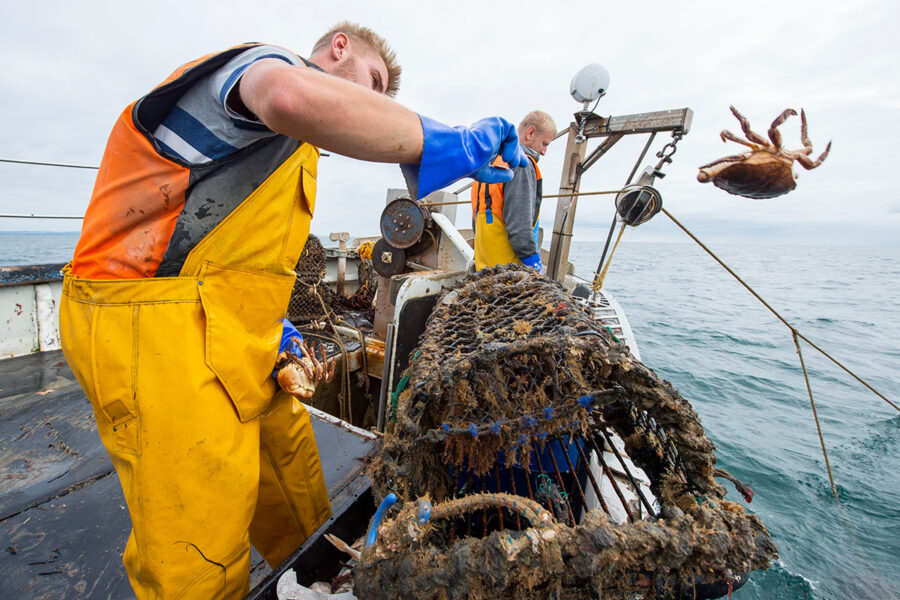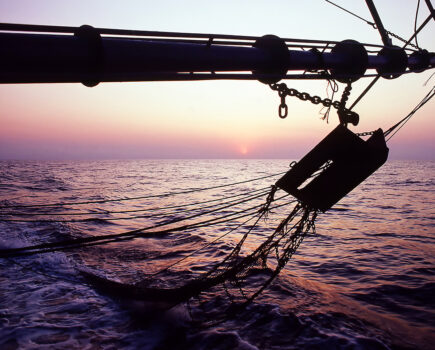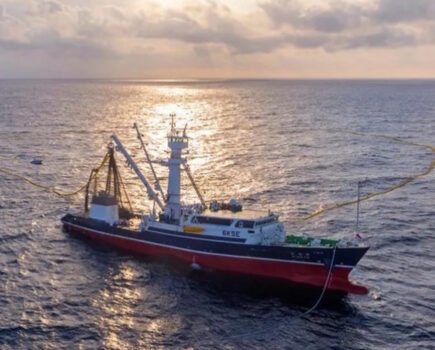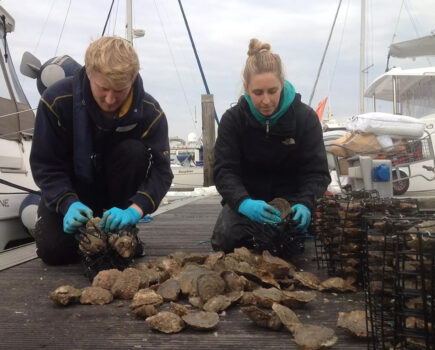The Blue Marine Crab and Lobster Symposium last November brought together scientists, managers and fishermen to discuss the way ahead.

Late last year, the Blue Marine Foundation hosted an intense one- day Crab and Lobster Symposium attended by a range of scientists, fisheries managers and a few reps from the catching sector.
Thirty short talks covered a wide range of topics in five groups; there were also Q&As and a final open forum. A recording can be viewed at: bit. ly/3ZphsQ2 and a ‘Summary Symposium Proceedings’ report is in preparation for publication soon.
To put the symposium into context, this article first reviews the expansion and stock status of the potting industry under current regulations, before describing the symposium talks and upcoming management challenges. My viewpoint is that of a former Cefas scientist, MSC assessor and SAGB life member.
The expanding industry
Potting for lobster and crab has changed dramatically in recent decades. Seasonal fishing inshore continues, but effort further offshore has risen substantially. Modern vessels fish a longer season, using increasing numbers of modern creels, parlour and inkwell pots in previously unfished areas, including Scotland, off the Humber, the German Bight, the Western Channel and the Celtic Sea.
Despite problems over live exports to China and the EU, and the slow pace of non-quota species negotiations, new state- of-the-art vivier vessels are still joining the fleet, and the obvious question is whether this scenario is sustainable.
Regulating for sustainability: two steps achieved out of three needed
Globally, sustainable harvesting requires regulations that protect spawning stock and limit harvesting to a level equivalent to maximum sustainable yield (MSY). This means preventing the landing of immature animals, optimising egg production, and limiting catch or effort to some measurable MSY proxy.
Some aspects of our crab and lobster management are good. We generally meet the first aim in the UK through various minimum landing sizes. The second aim is greatly assisted by national bans on landing berried crab and lobster, and by v-notching schemes.
However, the critical third aim is not yet met, as there are no national crab and lobster effort or catch limits, and there is a pool of dormant but tradable shellfish permits.
Managing stock status
Cefas and Marine Scotland scientists estimate crab and lobster stock status for large assessment areas that differ between the two species. Lobsters are more coastal and local, whereas crabs spread further offshore, and mature hens can migrate long distances.
Assessments use the size profile of pot-caught landings sampled at the main landing places, convert it to an age- structure using growth data, and adjust for an assumed natural death rate. The higher the harvest rate (fishing mortality ‘F’, in science-speak), the steeper the slope of the size and age structures. Potters can often see this on their own grounds, when larger animals become scarcer over time as potting effort increases.
Since the 1990s, the estimates of F for all lobster areas, and most crab areas, have been above (crab) or well above (lobster) estimates of MSY.
Since retiring in 2004, I have advocated in numerous meetings, summits and reports the need to introduce measures to ensure sustainability. While it is fair to say that crustacean stocks have not yet collapsed, I consider a lack of action to be a risky experiment that needs a realistic response under the impending Fisheries Management Plan (FMP) processes.
Key symposium topics
Recent fishery trends
An MMO talk on data for 2018-22 showed that lobster landings (mainly by under-10s) are stable, but that brown crab landings from all vessel sizes have fallen by 57%. The MMO does not collect matching data on effort.
Trends shown by Devon and Severn IFCA data were similar, with lobsters stable since 2010, but crab falling since 2014. A Jersey talk showed that catch per unit effort for Jersey boats is also down – 38% for lobster and 58% for brown crab, although lobster juveniles and spider crab have increased, the latter by 281%. English recaptures of hen crab tagged in Jersey suggest that stock trends in both areas will be related.
The signals from these talks are a warning that needs further probing.
Additional threats
Three presentations from the North East heightened concerns about the die-offs there, which sadly were not the only such issues discussed at the forum.
Cefas described new amoebic pathogens found in crabs caught off Selsey in the English Channel. Low infection levels caused sloth, but bad cases caused organ damage and death after capture. It was stressed that such pathogens were not found in samples from the North East. Sampling is ongoing at five locations.
In the Eastern Channel, a long-term project (CHASM) is studying how sedimentation affects crustacean habitat in the coastal ecosystem from Chichester to Pagham. Worryingly, we learned that early results have found changes in sedimentation, a rising heavy metal burden in crab and lobster tissue, and less oxygen in the seawater, backing up concerns reported by fishermen.
Lobster restocking and genetics
In the 1980s, my team was part of a group that learned how best to produce and release large numbers of hatchery-reared juvenile lobsters. They were microtagged, and some mature adults were later landed.
The National Lobster Hatchery has built on that by releasing nearly 300,000 juvenile lobsters over the years at chosen Cornish sites, and Whitby Lobster Hatchery could potentially kickstart lobster stocks south of the Tees – but hatchery rearing is still a chancy business, and will not be a cheap or quick fix.
The workshop heard from Exeter University that growing knowledge on lobster DNA may make it feasible to distinguish between hatchery and wild animals on the ground.
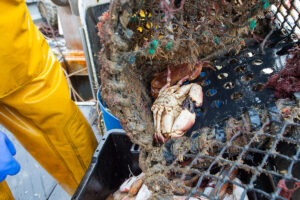
FN has reported in detail the concerns about sedimentation in the English Channel, including these dying crabs photographed on the Selsey potter Rapid Return. (Photo: Geoffrey Lee)
The IFCAs
A majority of the 10 IFCAs managing crustacean fisheries inside six miles gave presentations. All have differing byelaws managing their fisheries, and they all also have data collection systems. Two have pot limitation schemes.
An Association of IFCAs policy report stressed that because IFCAs only cover the six-mile zone, they must be properly integrated into the upcoming FMP process.
Managing into the future
Two key talks discussed the new groups set up in 2020 to develop an evidence-based crab and lobster FMP, as required under the 2022 Fisheries Act. An initial draft is due this autumn. The Crab and Lobster Management Group, supported by two advisory groups, has reviewed shellfish data collection, assessments and management needs, in order to draft a research plan and shape the FMP.
The FMP will ultimately inform decisions on how the fisheries should be managed to achieve sustainability. With a need to reduce overall effort to prevent overfishing, some elements of this plan are bound to prove to be controversial with fishermen.
Seafish and Defra have held a series of online and coastal meetings to raise awareness and invite participation in the FMP process. The Shellfish Industry Advisory Group, set up by the NFFO and the SAGB in 2020, will have the key task of reviewing the recommendations arising from these discussions about the new FMP.
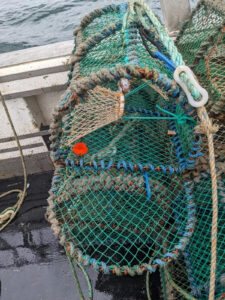
One presentation at the symposium was on the innovative Western Isles pot limitation scheme, a collaboration between
St Andrew’s University and
the Western Isles Fishermen’s Association. The orange disc shown attached to the inside of the creel is a Bluetooth RFID tag that transmits a unique ID to the tracking device when onboard the vessel, showing when and where the creel is shot and hauled. The tags are being used to validate the model used to determine shooting, hauling and therefore soak times. Once the model is validated, the tags will no longer be needed. (Photo: Coastal Resources Management Group/St Andrew’s University)
The final session
This began with an outline of SAGB priorities for crustacea. These include sustained efforts to regain access to the Chinese market, and to simplify live exports to the EU.
SAGB will continue to be a source of technical and scientific advice as the FMP is developed. We will continue to support the draft codes of practice for the capture and supply chains now that crustacea have been added the Sentience Bill.
SAGB also stressed the point that many active fishers are overloaded by meeting fatigue.
The open forum with which the symposium concluded saw vigorous discussion on the pros and cons of pursuing one-size-fits-all measures that are simpler and easier to administer, but don’t reflect very different fisheries and fishing patterns, or local legislation. As I pointed out, this is exactly where we were 30 years ago, but the stakes now are much greater because of the high effort.
The forum concluded with encouragement from one industry leader who commended the collaborative approach being taken by the Crab and Lobster Management Group FMP process.
The gaps
My opening remarks at the symposium noted that there are significant assessment and biological gaps in our understanding of our crab and lobster fisheries. Important life history differences between lobster and brown crab could affect sustainability.
For example, lobsters occur at relatively low density, depend on shelter, and produce relatively small numbers of quite large eggs and larvae.
In contrast, brown crabs are migratory, live at higher densities, and can produce millions of widely distributed small eggs.
With crab, however, it is the migratory hen crab that are most heavily fished in the autumn before they release their eggs the following year. Finally, the hen spawning cycle of both species is biennial, which could be a limiting factor. We really need to know how all these topics affect stock resilience.
Crustacean talking points
Although sustainability and FMPs were the key topics at the symposium, the wide range of speakers and topics meant that much else was learned over the two days, including:
- An MSC Fisheries Improvement Project on the sustainability of crab and lobster fishing in the Western Channel/Celtic Sea has completed a report on the aim of implementing a harvest strategy and control rule to meet the MSC standard. Potential measures discussed at local meetings include licensing, a cap on pot numbers, and unifying the MCRS in inshore and offshore areas. A strong point of an MSC-certified fishery is that the harvest strategy and control rule are pre-agreed.
- In 2021, the Scottish government was mandated to improve fisheries management, including for static gear.It plans to consult on new measures including capping vessel numbers inside three miles, and will monitor progress on FMPs in England. Talks on relevant studies in Scotland described the long-term closed-area trial in Arran, and a voluntary pot limitation and vessel monitoring trial with 140 vessels from the Western Isles Fishermen’s Association, who favoured this approach over others.
- Interviews with wind farm developers and potters in Wales and four east coast districts showed the main issues to be site- specific, and that the future requires a local approach, with pre-agreements on displacement, liability, insurance, loss and retrieval of gear. Potters preferred local area-based arrangements, but developers prefer a licensing approach.
- Twenty percent of UK seafood businesses apparently guide their buying using the Marine Conservation Society Good Fish Guide. This rates stocks including shellfish using published data on stock status, management and capture method. This is surely an incentive to improve our assessments and management performance.
- The ICES Working Group on the biology and life history of crabs aims to develop an international research programme for varied crab species relevant to a diverse national membership, but it was not clear if this includes benchmarking current assessments and developing alternative models. The chairman aired concerns over the recent fall in brown crab landings, and the issue of climate change.
This story was taken from the latest issue of Fishing News. For more up-to-date and in-depth reports on the UK and Irish commercial fishing sector, subscribe to Fishing News here or buy the latest single issue for just £3.30 here.
Sign up to Fishing News’ FREE e-newsletter here.
Main image credit: Geoffrey Lee

